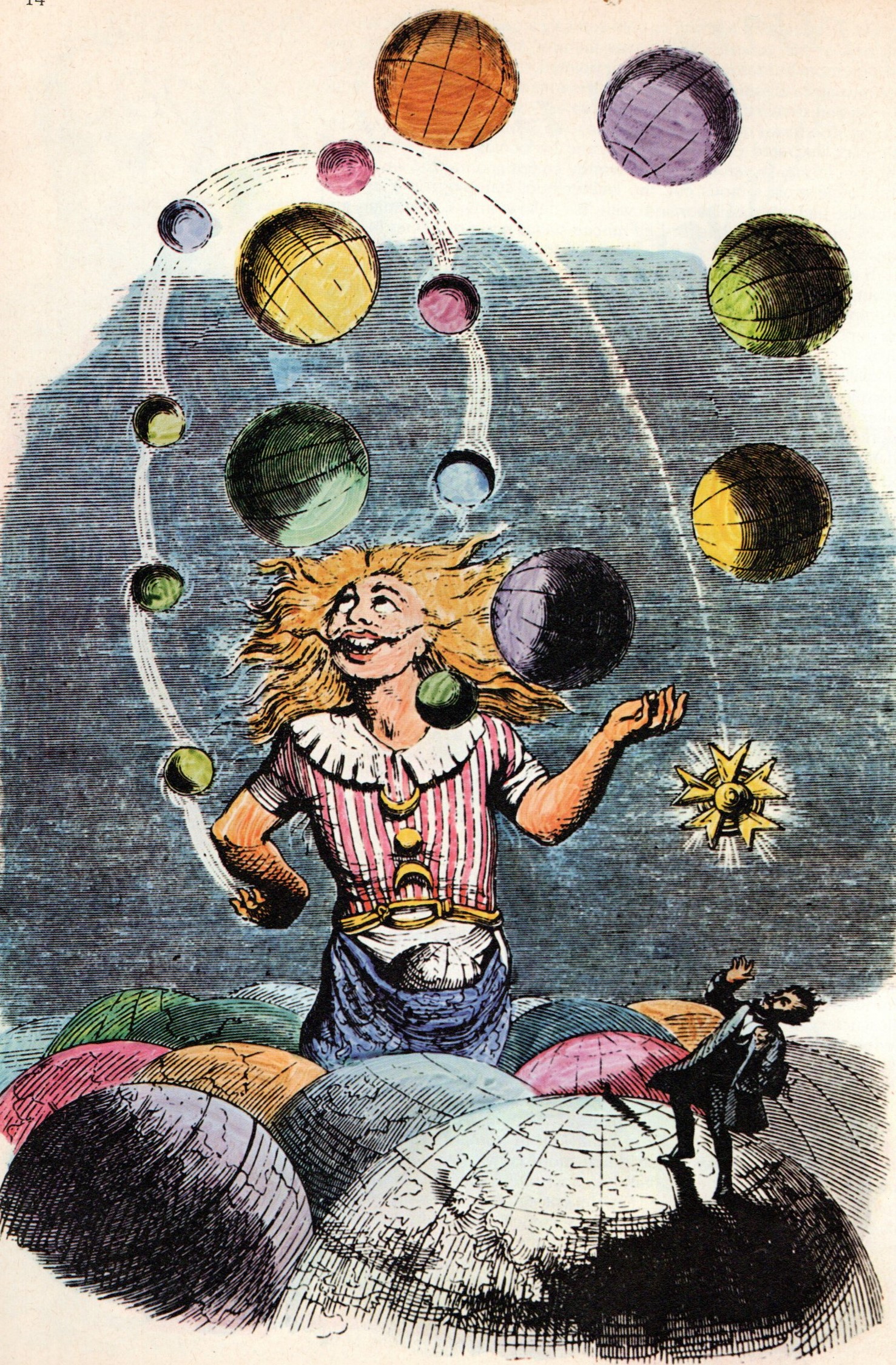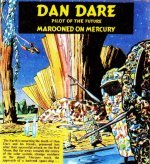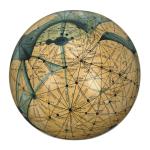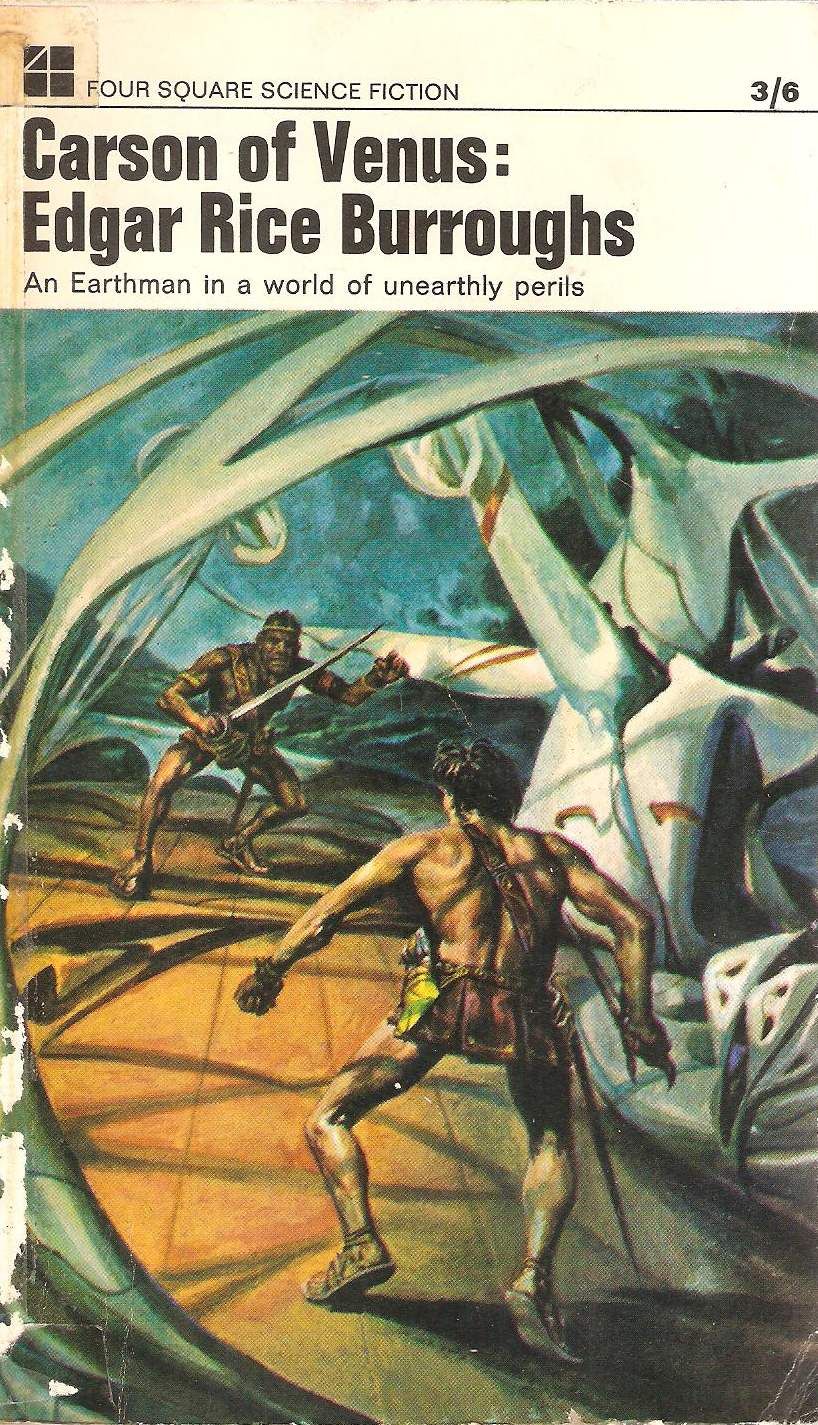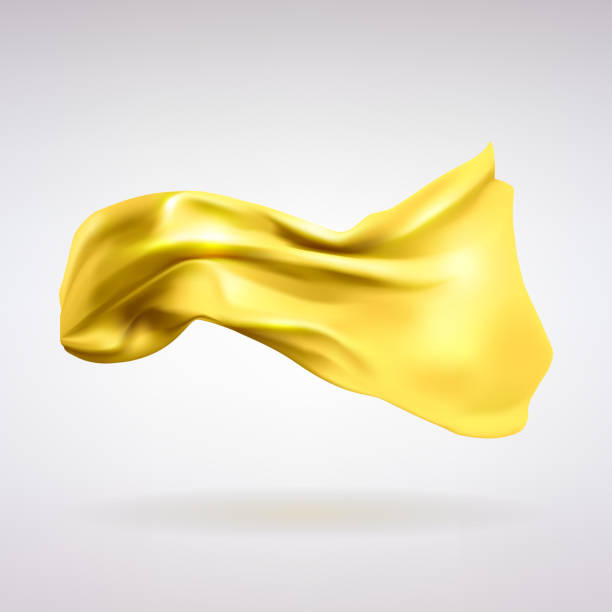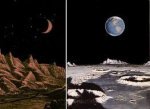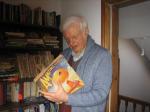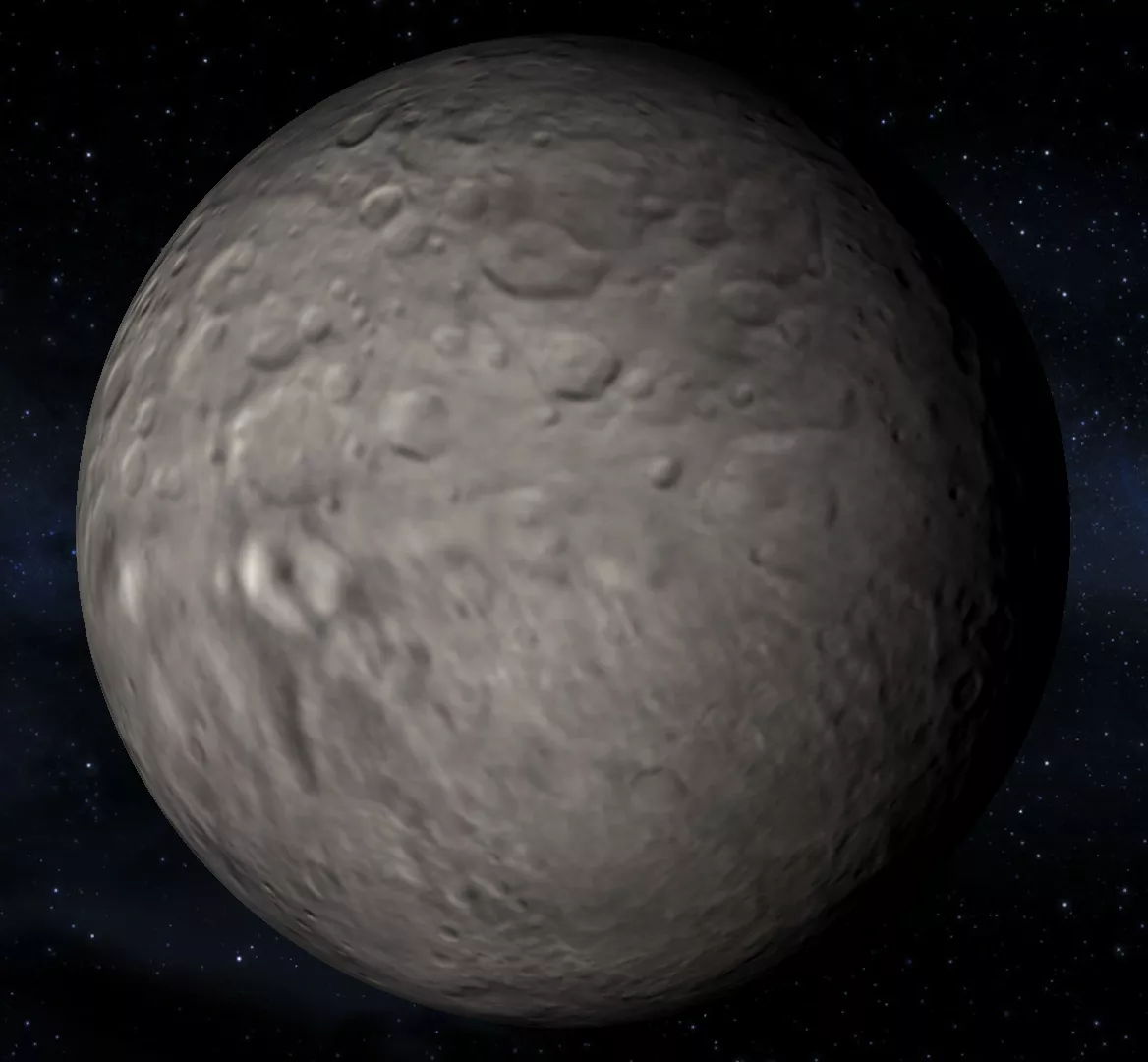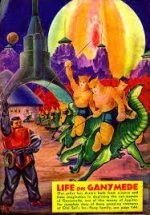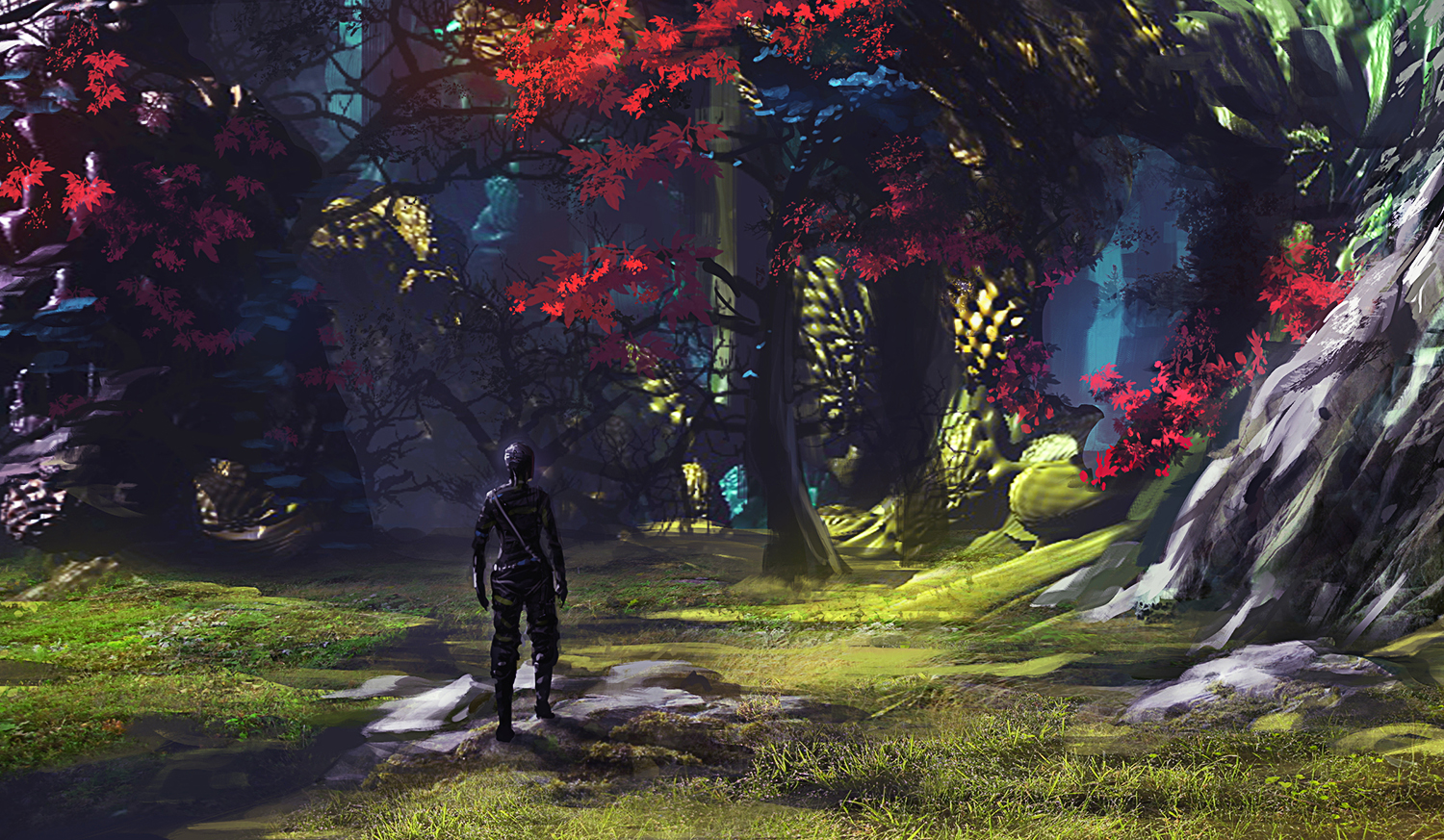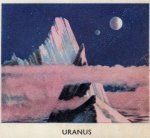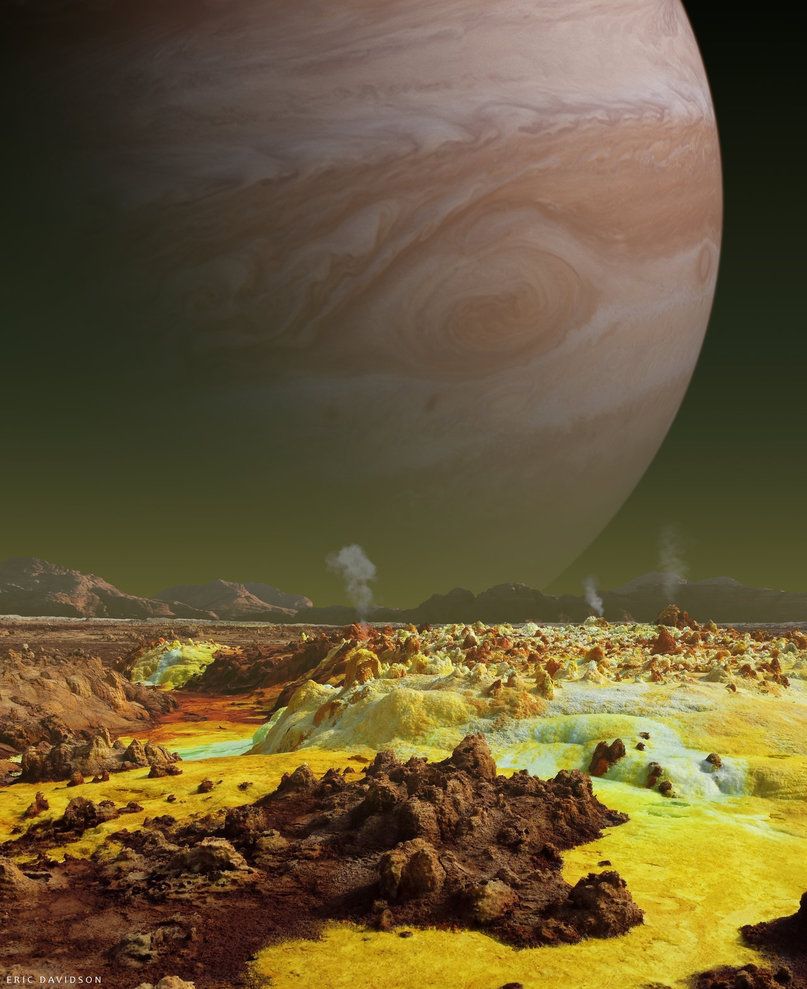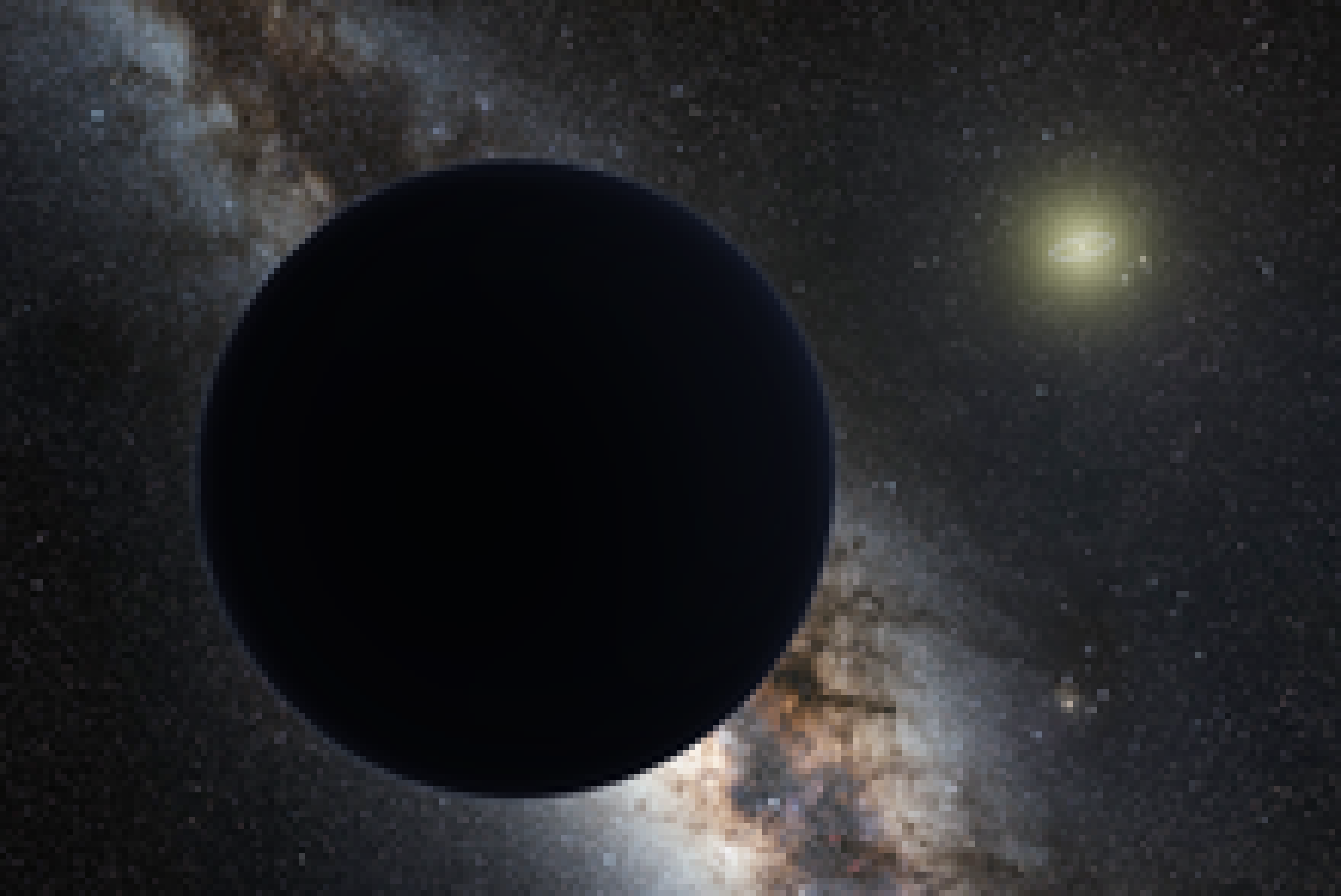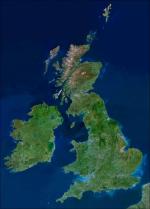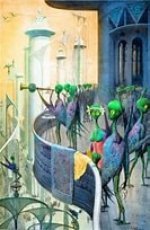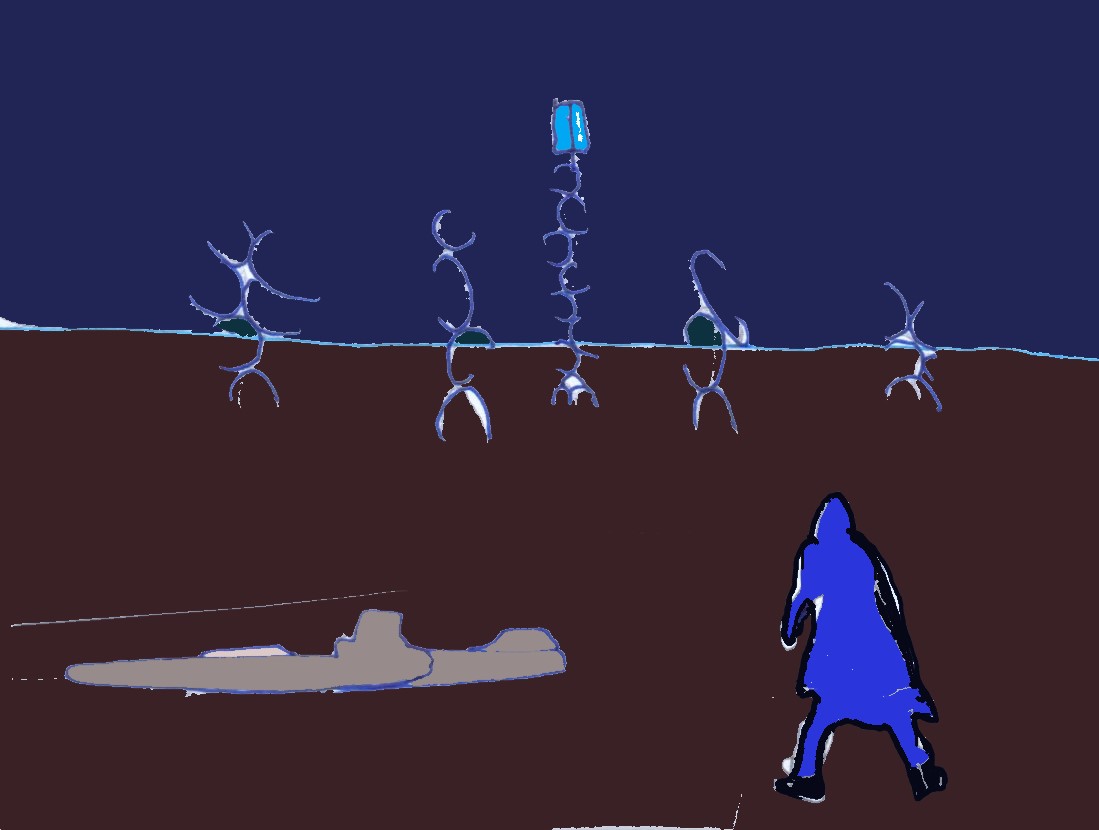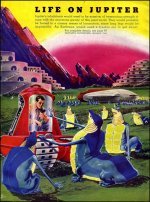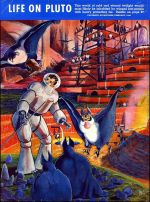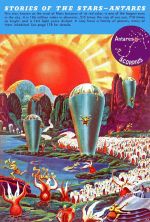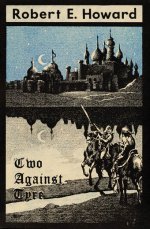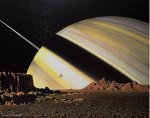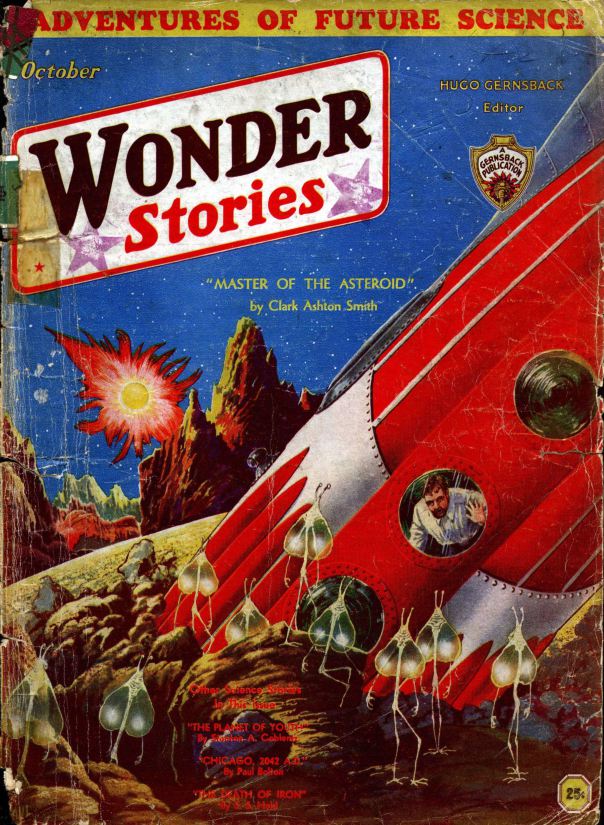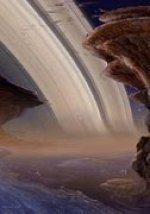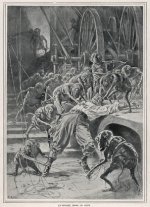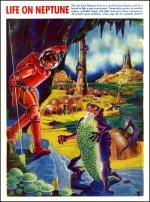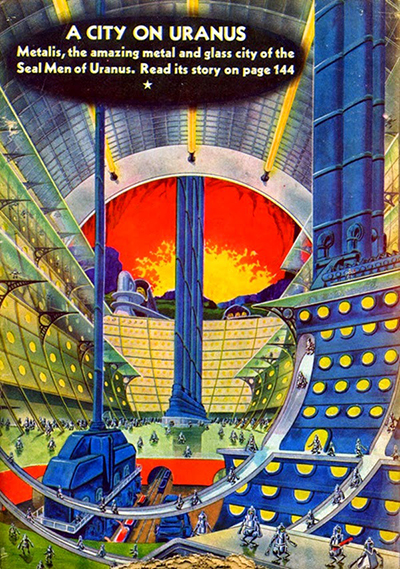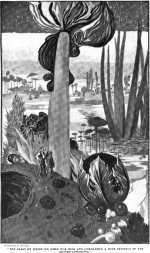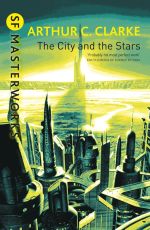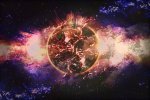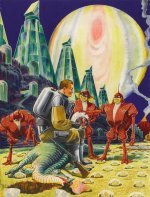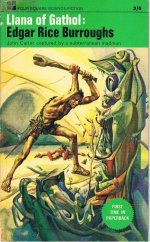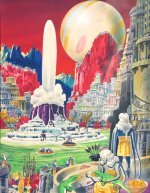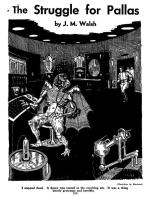- Home
- Saturn and its moons
- Titan
Titan
[ + links to: Pirates of Titan - What to see on Titan ]
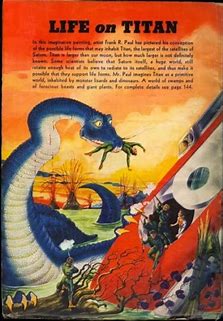 by Frank R Paul
by Frank R PaulSaturn's largest moon (by a long way), Titan deserves proper notice in Old Solar System science fiction.
Question: does it get what it deserves?
Or, to put it more bluntly: do we get what we want, as readers, from tales about Titan?
Stid: From your tone I take it the answer is going to be No.
Zendexor: Well, look at this this way. Can you tell me of a single OSS novel set on Titan?
Harlei: The evil parasites in The Puppet Masters come from there.
Zendexor: Yes, and at the end of the book their Earth victims - having thrown off their yoke - are on the way to Titan by spaceship to exact revenge. Unfortunately we're not told what happens at the end of that voyage. By all means read The Puppet Masters - you couldn't ask for a more gripping alien-invasion story - but for views of Titan we need to look elsewhere.
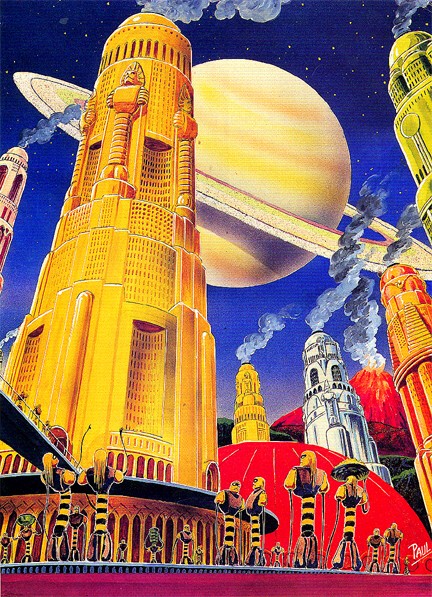 by Frank R Paul
by Frank R PaulHarlei: Here's a challenge for us all: to find a story that will live up to the Frank R Paul illustrations of life on Titan.
Zendexor: Especially the second one - a scene typifying the Old Solar System in all its irresistible cuddly wonder. It's the back cover for the November 1941 Astounding Stories, and the blurb calls it Orro, "Golden City of Titan".
Stid: In fact you'd see Saturn's rings edge-on from Titan, but never mind.
Zendexor: Right you are - never mind anything that gets in the way of our enjoyment of this vision.
I trust that any reader of The Sirens of Titan and Imperial Earth will, after looking at the Frank R Paul picture, understand why I give scant consideration to those stories here. They do have Titanian scenes, but those scenes are without much OSS flavour. Imperial Earth is 1970s-modern and realistic, and The Sirens of Titan... well... listen to this.
The atmosphere of Titan is like the atmosphere outside the back door of an Earthling bakery on a spring morning.
Titan has a natural chemical furnace at its core that maintains a uniform air temperature of sixty-seven degrees Fahrenheit.
There are three seas on Titan, each the size of Earthling Lake Michigan...
There are woods and meadows and mountains...
And that, apart from some large birds, is that. Not very Titanic. The scenes contain plenty of invention but it's mostly to do with an alien robot from another solar system. Memorable stuff, well worth reading, but not OSS-flavoured.
The question is - where can we find instances of that flavour, to put on this page?
I'll tell you: we shall just have to look around for scraps. And thus eke out a meal for our imaginations.
Harlei: Hmm... not sure I'd dismiss Flight on Titan as a "scrap".
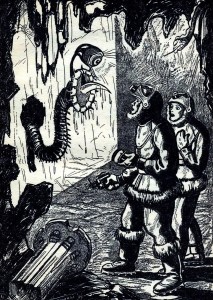 Titanian threadworm
Titanian threadwormZendexor: It's twenty-three pages of good enough story, I'll concede that. Appearing in the January 1935 Astounding Stories, it is set in the year 2142. Tim and Diane Vick, having lost their money in a financial crash, aim to recoup on Titan - where precious gems called "flame orchids" can be obtained by trade with the natives.
This version of Titan has a breathable atmosphere, is barely habitable and has been claimed by the USA. (In stories written before the 1967 Outer Space Treaty, you could plausibly write of celestial bodies annexed by a country.) When disaster (in the form of a collapsing ice mountain) strikes the Vicks' shelter, they have to try to reach Nivia - the human settlement on this frigid world - a hundred miles away across the Mountains of the Damned. Against all the odds, they win through.
Now, since the hero and heroine are prospectors or traders rather than scientists or philosophers, it's fair enough that they treat each phenomenon as it comes, so you just get one thing after another.
...The native slithered through like a walrus, his streamlined body seallike and glistening with its two-inch protective layer of blubbery flesh. As Tim cranked the door shut, the creature raised the filmy underlids from its eyes, and they showed large, luminous, and doglike... not much more intelligent than a St. Bernard dog, perhaps, but peacable and inoffensive, beautifully adapted to its forbidding environment, and the highest form of life yet known on Titan...
...Once they dared to penetrate the grove of rubbery and elastic whiplash trees that grew in the shelter of the nearest cliff. The things lashed out at them with resounding strokes, not violent enough to fell them, but stinging sharply even through the inch-thick layer of sponge rubber that insulated their bodies from the cold...

...the crystal bubbles of the ice-ants marked the glacial surface of the hills, but these creatures never emerged, laboring incessantly beneath their little domes that grew like mushrooms as they melted within and received fresh deposits of ice crystals without...
...In the curious chamber, walled half by ice and half by rock of the mountain, lay what was unmistakably a fallen, carved column... [This is the one and only hint in the story, that there may once have been a Titanian civilization.]
...they turned to stare at the creature emerging from a hole in the rock wall. A face - no, not a face, but a proboscis like the head of a giant earthworm, that kept thrusting itself to a point, then contracting to a horrible, red, ringed disk... above it on a quivering stalk, the ice-green, hypnotic eye of a Titanian threadworm, the first ever to be faced by man...
As I say, one thing after another; a linear, episodic tale. I think it may be the best we have.
Harlei: Sounds a bit as though you're "damning with faint praise".
Zendexor: If so, it's not intentional. The story is fine as it is, and I know it can't be what it isn't.
Stid: What he wants is the Frank R Paul picture translated into prose.
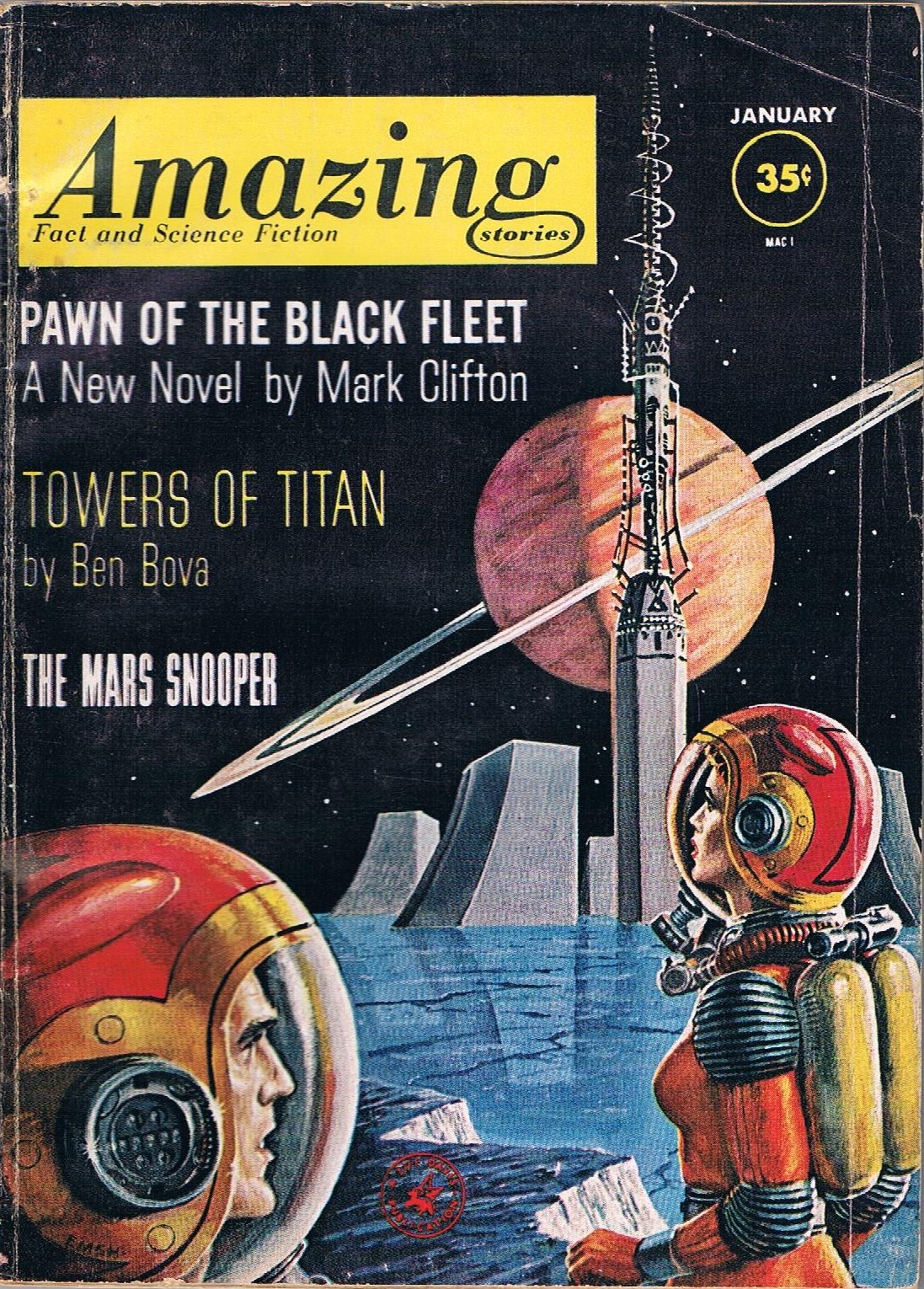
Zendexor: Well put, and no need to lift the eyebrow when you say it. The Paul picture gives us a glimpse of a developed world with its own advanced culture - a civilization with indigenous personality.
That's something you tend not to get from most stories set on Saturn's big moon; tales such as The Towers of Titan where that locale merely happens to be the site of a malevolent machine stationed there by our interstellar foes... Or The Harpers of Titan, in which the human "natives" of that moon are obviously not real indigenes - though at least the creatures known as the Harpers do seem to have evolved locally.
Harlei: How about Trouble on Titan? That's to say, not the novel of that name by Alan E Nourse, but the novelette by Arthur K Barnes.
Zendexor: I've got reservations about that one.
Stid: I bet you have. COMOLD - right?
Harlei: But wait - you sure you know which story I'm talking about? The one with the Gora? Your "common origin let-down" doesn't apply to them -
Zendexor: Quieten down, both of you, and let me approach this topic in my own way.
First of all let's appreciate the happy-go-lucky manner in which space explorers could go about their business in those days: Gerry Carlyle, the lady space-captain in Trouble on Titan, forced to make an emergency landing, picks up a reference book -
and quickly flipped the pages. Titan was extraordinarily rich in minerals of almost every conceivable type. Only transportation costs prevented mining there. Also, its atmosphere was breathable, its temperatures apparently not lethally extreme.
More remarkable, according to Murray's writings, there was civilized life on Titan. The cities there had been built with an amazing genius for metal-working. But Murray's notes were sketchy on the subject. It seemed that the inhabitants of Titan were few in number and difficult to communicate with, though quite friendly.
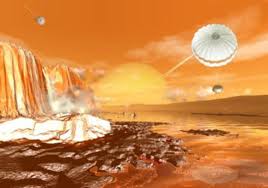
Stid: Yeah, that's the spirit. No space probes, mission-control centres, billion-dollar orbiting surveys, landers, or sample return missions; you just blast off and leave sketchy notes for the next pioneer.
Zendexor: Makes one wistful, does it not? To continue:
The fact that highly evolved life existed on the satellite was not startling. Advanced civilizations had been discovered in at least three other places in the System. If any nomadic tribe, gifted with the ability to work in metals, had wandered in from outer space and decided to locate in the Solar System, it was only natural for them to select Titan and its wealth of ores...
Stid: As I thought. Not original natives at all. Not real Titanians.
Zendexor: Sad, isn't it - the assumption that any highly evolved life must have come from elsewhere. However, these interstellar-origin "Titanians" aren't the whole story.
"It is the Time of Offering now. We must retire. Please do not go away. We shall awaken shortly. Our homes are yours."
Bowing ingratiatingly, the Titanians lay down upon their curiously constructed beds and instantly dropped into a coma. All through the buildings came the rustling, pattering sounds of tiny feet. The party from the Ark watched in wary bewilderment. The tension was snapped by Gerry's gasp.
"Look there - coming up through the hole in the floor!"
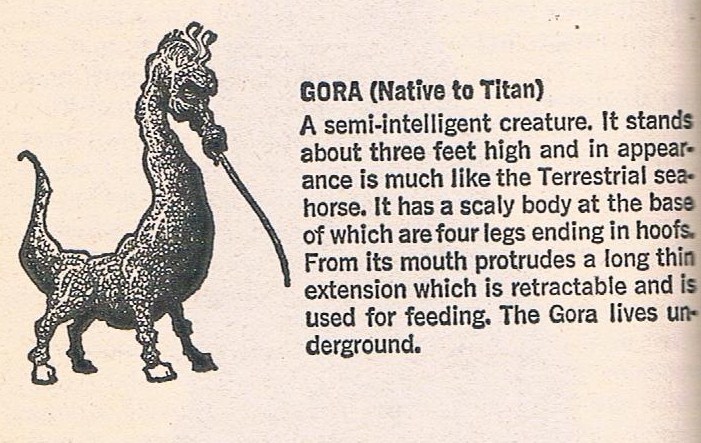
It was a hideously malformed little devil that stared around with bright, beady eyes at the intruders, then popped out into the room. It stood about three feet high, in appearance much like a sea-horse. At the base of the nauseous, scaly body there were four short legs, ending in hoofs. The creature seemed top-heavy. Just as the Titanians were the epitome of kindliness, this thing was stark evil.
This species is called the Gora, and it is evident that we are not meant to like them. Sure enough, it does something that looks thoroughly bad:
The hoofs made a faintly disturbing clop-clop as it crossed the room to bend over one of the sleeping Titanians. From its snout protruded a long, thin extension that was almost needle-like. Before anyone could speak or interrupt, it was plunged into the throat of the Titanian!
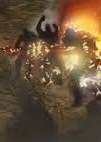
Action erupted in a quick flurry. Someone had his heat ray out in a flash... The monster doubled up in quick pain... It crashed against the front wall and collapsed, smoking from half a dozen heat ray blasts.
There, that'll teach the squamous critter to be so starkly evil.
Only trouble is, it turns out that the Gora's apparently vampiric behaviour, sucking a glandular secretion out of the "Titanian", was actually part of an agreed pact between its species and the "Titanians". As one of the latter soon explains:
"...After all, the glandular secretion was of no particular importance to us. So we agreed that twice every planetary revolution we would set aside a brief period.
"During that time, the Gora are permitted to come up from below and replenish their supplies of the secretion. This period, known as the Time of Offering, is marked by the great gong. In return, the Gora agreed to take over all manual duties in running the city and keeping it in a fine state of repair. They clean our homes, operate all our machines, while we are free to engage in cultural pursuits and enjoy the more abundant life..."
The odd thing is, the "Titanian" also admits that his own species originally came "from a far star", whereas the Gora "are native to this world" - in other words (as I would say if I had been writing the story) the Gora are the real Titanians.

But this aboriginal status doesn't do them any good; dead Gora lie in heaps by the end of the story - there's no sympathy for them at all when they get in the way.
It all comes of being scaly and evil and inferior.
A bit more prestige would not come amiss. The bumblebee-men in the Frank R Paul picture have obviously got it. But I can't find a story to fit.
I therefore maintain that there's a vacancy - a gap in the literature - still waiting to be filled by a classic OSS Titan saga, a full-blown adventure novel set on that moon.
Harlei: Such as Leigh Brackett might have written but unfortunately did not. Now that would be something. You know, I reckon she missed an opportunity: if only her last three novels had been set on Titan instead of that invented out-system world, Skaith! To me, Skaith feels like Titan ought to feel. Cold and ancient and eerie.
Stid: "Symbolic" cold - that's what you OSS fans must want for such a story. Like the cold on Captain Future's Pluto, where the natives are shaggy and Earthmen have to wear furs. Nothing like the real cold on the real Titan, of course. Just a kind of tokenism, a nod of respect towards reality, without actually adhering to the facts. I understand the principle very well, though I wonder if we shouldn't encourage other approaches as well.
Zendexor: Other approaches? Such as?
Stid: Such as veering towards OSS fun-and-games from, uh, let's say, the other end of the spectrum.
Zendexor: You intrigue me, Stid. I get the feeling you're trying to say something subtle - a welcome development, I must say. Let me guess: you are suggesting that perhaps some realistic authors, the NSS type of writer, may succeed in introducing an OSS element into their tales under a realistic guise? And to be specific, this element might apply to the existence of life on Titan?
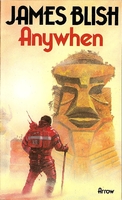
Zendexor: Life on Titan?
Stid: Life on Titan, both Terran and native, in the amazing story, How Beautiful with Banners. The native life - the "flying cloaks" - seems weird enough. But that's only the half of it. For me the great originality of the story lies in the way the Terran explorer is able to rove around on Titan without a spacesuit. The protagonist, and hence the reader, experiences that world with OSS-type freedom using NSS technology. (See Feeling Naked on Titan - Response.)
Harlei: It's achieved by use of a force-field, I suppose. The only way to keep out the cold.
Stid: No, you guessed wrong! A force-field would be a cliché, and I told you this story is original. Listen to this, and then think: might this be the really viable future of the OSS? A reification of outdated imaginary scenes by more modern contrivances?
Feeling as naked as a peppermint soldier in her transparent film wrap, Dr. Ulla Hillström watched a flying cloak swirl away towards the black horizon with a certain consequent irony. Although nearly transparent itself in the distant dim arc-light flame that was Titan's sun, the fluttering creature looked warmer than what she was wearing, for all that reason said it was at the same minus 316°F. as the thin methane it flew in. Despite the virus space-bubble's warranted and eerie efficiency, she found its vigilance - itself probably as close to alive as the flying cloak was - rather difficult to believe in, let alone to trust.
The machine - as Ulla much preferred to think of it - was inarguably an improvement on the old-fashioned pressure suit. Fashioned (or more accurately, cultured) of a single colossal protein molecule, the vanishingly thin sheet of life-stuff processed gases, maintained pressure, monitored radiation through almost the whole of the electromagnetic spectrum, and above all did not get in the way. Also, it could not be cut, punctured, or indeed sustain any damage short of total destruction; macroscopically, it was a single, primary unit, with all the physical integrity of a crystal of salt or steel.
If it did not actually think, Ulla was grateful; often it almost seemed to, which was sufficient. Its primary drawback for her was that much of the time it did not really seem to be there.
 the real thing
the real thingHarlei: So that's it: I see what you mean, Zendexor. With a "suit" like that you can go around seemingly unclothed on a world with temperatures close to absolute zero.
Zendexor: ...While giving the natives the wrong impression of what humans are. Distant shades of the misunderstanding with the Jovians discussed on the page Asimov on Jupiter - but with a very different outcome.
"Misunderstanding", though, is not the word one ought to use for the very different disparity of vision we get in The Game Players of Titan, where we get a glimpse of ourselves and our world as they appear to the Titanian "vugs".
...Stunted, alien creatures, warped by enormous forces into miserably malformed, distorted shapes. Crushed down until they were blinded and tiny. She peered at them; the waning light of a huge, dying sun lit and relit the scene and then, even as she watched, it faded into dark red and at last utter blackness snuffed it out once more.
Faintly luminous, like organisms inhabiting a vast depth, the stunted creatures continued to live, after a fashion. But it was not pleasant.
She recognized them.
That's us. Terrans, as the vugs see us. Close to the sun, subject to immense gravitational forces. She shut her eyes.
I understand, she thought. No wonder they want to fight us; to them we're an old, waning race that's had its period, that must be compelled to abandon the scene.
And then the vugs. A glowing creature, weightless, drifted far above, beyond the range of the crushing pressures, the blunted, dying creatures. On a little moon, far from the great, ancient sun.
You want to show us this, she realized. This is how reality appears to you, and it's just as real as our own view.
But - no more so.
Do you grasp that? she asked the glowing, weightless presence that was the spiralling Titanian. That our view of the situation is equally true? Yours can't replace ours. Or can it? Is that what you want?
She waited for the answer, her eyes squeezed shut with fear.
"Ideally," a thought came to her drily, "both views can be made to coincide. However, in practicality, that does not work."
Opening her eyes she saw a blob, a mound of sagging, gelatinous protoplasm - ludicrously, with its name stitched to its front...
pure frontier adventure on a middling-alien titan
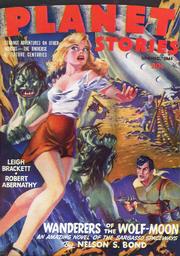
Lastly let's consider Wanderers of the Wolf Moon...
Stid: A good rollicking adventure tale, and a character-study of ill-matched crash-landed castaways... but is Titan really the point? I mean, it could have been anywhere...
Harlei: No, Stid, that's not how good OSS tales work. It is Titan because it says so.
Zendexor: Harlei has an impulsive, peremptory way of putting it but he's on the right track. The mere name of a world goes a long way towards validating a scene as being of that world, in the OSS sub-genre. It's not enough by itself, admittedly. But then, we do get given more in this story. The semi-lupine creatures with part-human faces... by means of events and actions they meld associatively with the sense of being on that particular world.
Besides, the Titan theme is developed planetogically e.g. via the long period of eclipse by Saturn, the snow storms...
Harlei: Like I said, it's a real Titan.
Zendexor: So we're ganging up on you, Stid.
Stid: Well, I'll not deny I enjoyed the tale. And I'll say this for it - it includes some juicy pseudo-scientific excuse-making:
..."I can't understand why this satellite is habitable at all. I was under the impression that Saturn is a frozen planet."
"It is. Its surface temperature is approximately 300 degrees below zero, Fahrenheit. But the warmth of its numerous satellites is one of the astonishing discoveries made by the early space explorers, fifty or sixty years ago. Scientists have not yet explained the matter satisfactorily. Some say the tremendous mass of Saturn, the waves of atmospherics set up by its swirling motion and the 'grindstone' of its ring, form an electronic barrier-shield for the satellites. Still others believe that frigid Saturn acts as a gigantic mirror or solar reflector for its children..."
Full marks for gift of science-gab!
Arthur K Barnes, "Trouble on Titan" (Thrilling Wonder Stories, February 1941); James Blish, "How Beautiful With Banners" (1966, commissioned for Orbit 1, ed. Damon Knight; also reprinted in the Blish collection, Anywhen (1971)); Nelson S Bond, "Wanderers of the Wolf Moon" (Planet Stories, Spring 1944); Ben Bova, "The Towers of Titan" (Amazing Stories, January 1962); Arthur C Clarke, Imperial Earth (1975, 1976); Philip K Dick, The Game Players of Titan (1963); Edmond Hamilton, "The Harpers of Titan" (Startling Stories, September 1950); Robert A Heinlein, The Puppet Masters (1951); Kurt Vonnegut, The Sirens of Titan (1959); Stanley G Weinbaum, "Flight on Titan" (Astounding Stories, January 1935)
For an old-style illustration of a rocky needle-peak landscape on Titan, see the Diary, Verticality.
For three Titan stories with the same name, see Treble Trouble on Titan.
See the Philip K Dick page for more on The Game Players of Titan - where I quote the same passage as I do here; I can't bring myself to delete the excerpt from either page, though normally I try to eschew such duplication on the site.
For Manly Wade Wellman's Sojarr of Titan see the relevant section in Jungle Moons.

